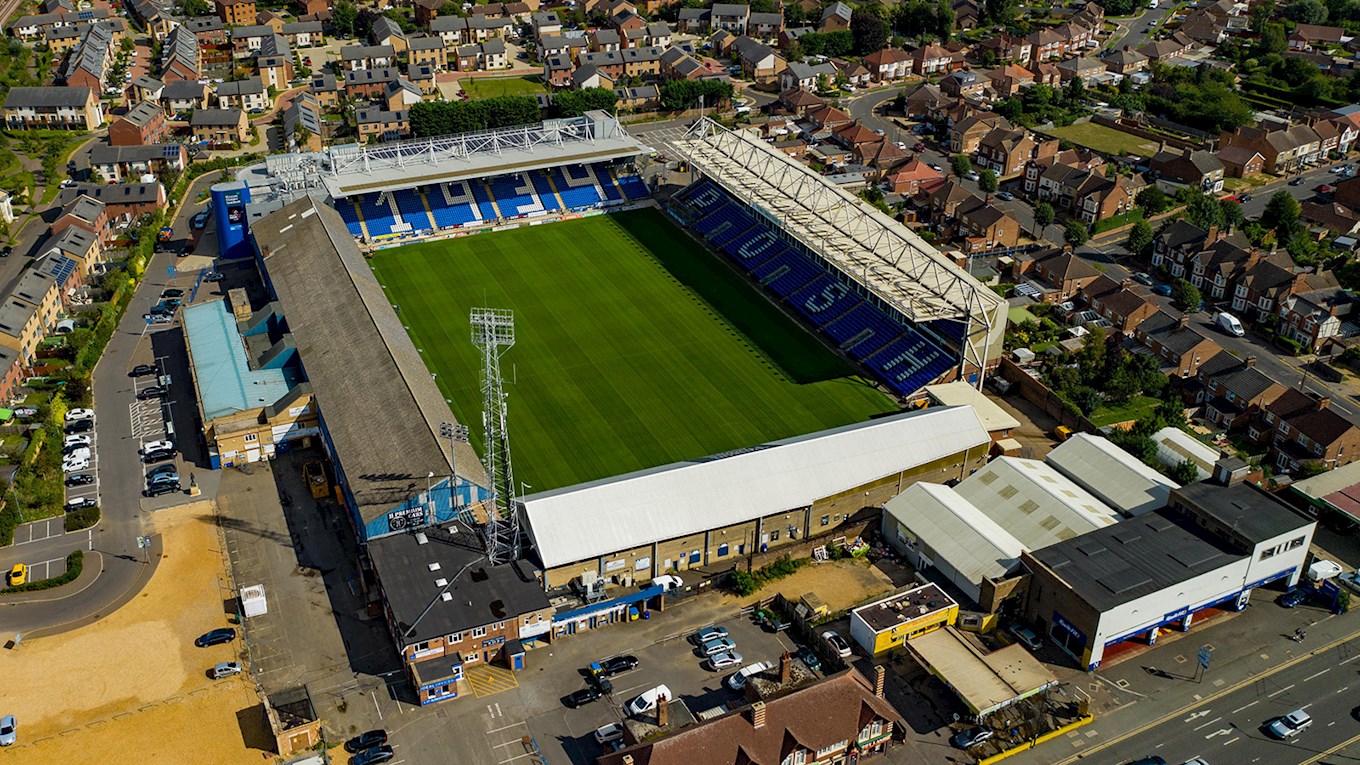The Weston Homes Stadium
Parking At The Weston Homes Stadium
On a match day, there is unfortunately no public car parking at The Weston Homes stadium. However, there is parking for cars in the Pleasure Fair Meadow council and Railworld car parks opposite the stadium (adjacent to the Town bridge on Oundle Road, PE2 9PR). For traffic, travel and parking information from the Peterborough City Council, click here.
During normal office hours, visitors parking is available at the stadium. Enter via Hawksbill Way on non-match days.
Stadium Plan

Capacities
The Meerkat Family Stand
4,637
Main Stand (Home)
2,254
Main Stand (Away)
1,888
GH Display Stand
2,557
Weston Homes London Road End (Rail Seating)
2,175
Total Capacity without segregation: 13,511
Directions To The Weston Homes Stadium
By car from South (A1): Exit the A1 at junction 17 and follow signs to Peterborough (A1139) onto the A1139 Fletton Parkway. Exit the Fletton Parkway at junction 3. At roundabout turn left onto the A1260 Nene Parkway. Take first exit and at roundabout turn right. Turn left at the next roundabout onto Shrewsbury Avenue. At T-junction after half a mile, turn right into the A605 Oundle Road. Follow road for one mile. Access to the stadium is straight on at traffic lights just before the town bridge.
From North (A1): Exit the A1 at signpost ‘Leicester, Peterborough North A47’. Turn left onto the A47. Exit the A47 after 5 miles, at junction 15. At the roundabout turn right onto the A1260 Nene Parkway. Exit the Nene Parkway after 1 mile. At the mini-roundabout by the ‘Gordon Arms’ turn left onto the A605 Oundle Road. Access to the stadium is straight on at traffic lights just before the town bridge.
From East (A47): Exit A47 at junction 18 and follow A15 all the way to the stadium.
By foot from railway station: Turn right out of station and head towards the main road (Bourges Boulevard). Turn right and head towards the big roundabout. Use the pedestrian underpass and head past Asda. At the traffic lights, turn right and the ground is situated on the left hand side over the town bridge. There are of course plenty of taxi cabs available from the Railway Station if you don’t fancy the 10 minute walk.
Stadium History
Football has been played at Peterborough United's London Road home for well over a century but the present stadium, with seats for more than 10,000 and a total capacity of 15,314, bears no resemblance to the ground seen into the 20th century by Peterborough City before Peterborough and Fletton United enjoyed a successful run until collapsing in financial disarray during 1932.
Following formation in 1934, present club Peterborough United took over a City Council-owned ground little changed since the turn of the century with a single wooden stand seating no more than 250 and raised earth banks behind either goal.
The City Council backed the new club by building brick dressing rooms and a committee room at the back of the wooden stand and this served right through until the late 1950s and construction of the present North Stand. In their early seasons of Midland League football Posh attracted crowds of between three and four thousand and it took a boxing promotion to set an attendance record in the summer of 1939.
More than 18,000 saw 'Fen Tiger' Eric Boon of Chatteris successfully defend his British title against Scotsman Johnny McGrory but there was criticism of the club directors who charged the boxing promoter only a paltry £20 for use of the ground.
After the Second World War terracing and a covered shelter were provided at the popular London Road end, although the narrow Glebe Road side was still stepped with re-cycled railway sleepers and partially covered by a shelter erected at the Moyes End in 1939.
During the early war years with Posh restricted to playing friendlies, income dwindled and with the club unable to pay its rent, Peterborough City Council threatened to terminate the ground lease. In 1942 it looked like the end when a local factory sports club offered to take a 10 year lease. Posh owed £50 in rent and were saved only when two individuals came up with the money.
Later, a more sympathetic Council negotiated a long term lease and eventually sold London Road to Peterborough United for a nominal sum during the 1950s, although with the built-in safeguard of covenants restricting the use of the area for anything but a sports stadium.
London Road, as it is today, really began to take shape in the early 1950s with the driving force behind the development and most of the money coming from a flourishing Supporters' Club. Parent club share capital was doubled to £4,000 by the creation of an extra 8,000 five shilling shares which were eagerly snapped up.
A development fund was jointly set up by Posh and the Supporters' Club and various fund raising schemes included one in which fans could by a brick for half a crown! A first project in 1953 was new covered terracing behind the Moy's End goal with a matching facility following within a couple of years behind the London Road End goal.
By 1956, the steelwork for the pitch long main stand was taking shape behind the old wooden stand and the new stand, with over 2,404 seats and standing enclosures in front, was opened for the 1957-8 season. The old stand was demolished and throughout that campaign the pitch remained in its old position before being moved some 30 yards north.
This allowed a new standing terrace to be created on the Glebe Road side which later had four executive boxes, topped by a television platform, erected at the back. The modern look to London Road had been completed in February 1960 when Arsenal provided the opposition in a game to officially launch the ground's first floodlights, the actual switch on ceremony being performed by Football League chairman Joe Richards.
After Posh gained Football League admission in 1960, attendance records crept well past the 20,000 mark with a new high of 30,046 for FA Cup action against Arsenal early in 1965. Then, for the next round against Swansea, this increased to a now never to be equaled 30,096.
When Posh gained promotion to the new First Division after a Wembley play-off success in 1992, seated capacity was below the levels required by the Taylor report and the shortfall was solved by converting the Main Stand's standing enclosures with around 700 seats bought second hand from Leicester City, when they re-developed one of the Filbert Street stands, and with a further 300 seats from Millwall's Old Den.
Then with 3,605 seats, the Main Stand's facilities were considerably extended to include a full time pub, executive and conference areas and a large retail shop, plus commercial outlets including a hair and beauty salon and a Betting Shop. A former Supporters' Club bar area was also extended to create office accommodation for the local Probation Service.
By the mid-1990s Posh were looking to provide even more seats by building a completely new 5,000 capacity stand on Glebe Road side. The contract worth £1.4 million went to Lincoln contractors Linpave who had completed similar projects for Lincoln City and Burnley. The Football Trust contributed around £900,000 and the old terraces were demolished in the summer of 1995 and the new stand was brought into use for the final few games of the 1995-96 season.
Initially sponsored by mail order specialists Freemans, it became the Thomas Cook Family Stand before the start of the 1999-2000 season.
Then London Road and Moy's End terraces, little changed since completion in the 1950s, were re-roofed and fitted with extended crush barriers to comply with increased safety requirements.
The 2001 close season saw the pitch receive its biggest make-over since being moved in the 1950s. The entire playing surface was removed, two kilometres of new drainage pipes laid and covered with 500 tones of gravel and sand. Fresh top soil was then laser graded before being re-seeded.
The Motorpoint Stand was officially opened to supporters on Saturday 22nd November 2014 for a fixture with Swindon Town after being built to replace the Moy’s End Terrace which housed away fans for decades. The stand, which includes a Future Business Centre, is now regularly used for youngsters as part of the club’s Schools Initiative, and has a capacity in the region of 2,600.
It was announced on Wednesday 26th November 2014, ABAX would sponsor the name of the stadium - London Road would now be known as ABAX Stadium.
On 10th May 2018, Weston Homes signed a five-year deal to sponsor the London Road Terrace - it would now be known as the Weston Homes London Road Terrace.
On 1st June 2019, the ABAX Stadium became The Weston Homes Stadium in a ten-year deal and on 24th June 2020, Deskgo signed a three-year deal becoming the naming sponsor of the East Stand.
On 30th January 2024, GH Display became the new naming sponsor of the East Stand.

